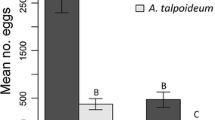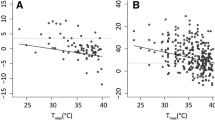Abstract
There is an important difference between cannibalism between unrelated individuals and between a mother and its offspring, because the former can be defined as a form of intraspecific competition, but the latter affects the inclusive fitness of individuals. Many examples of cannibalism have been reported in predacious phytoseiid mites. Furthermore, sib cannibalism avoidance is known in several species. However, whether females’ actually prey upon their offspring under starved conditions has yet to be established. Here, female performance towards their offspring under no-prey-other-than-offspring, water-available and humidity-selectable conditions, was observed in four phytoseiid species, Amblyseius eharai, Amblyseius swirskii, Neoseiulus cucumeris and Typhlodromus bambusae. Typhlodromus bambusae females only survived for 4.14 ± 0.42 days and there was a significant difference in survival duration between T. bambusae and the other three species (all survived more than 8 days). Neoseiulus cucumeris females survived longer than A. eharai and A. swirskii females, whereas there was no difference between A. eharai and A. swirskii females. On the other hand, the offspring (immature stages from egg to larva or protonymph) of A. eharai, A. swirskii and N. cucumeris died earlier in mother-presence than in mother-absence (egg alone) experiments, suggesting that cannibalistic interactions occur between mother and offspring. The survivorship of T. bambusae offspring in the mother-presence condition did not differ from the mother-absence condition, indicating that kin cannibalism is rare in this species. This must be related to the phenomenon that mothers tend to die before their offspring. The short longevity of T. bambusae mothers is one of the reasons why there is no significant difference in immature survival between the mother-presence and mother-absence experiments. Lastly, the reason(s) behind such variation in female phytoseiid performance towards their offspring is addressed in relation to the diet-specialization hypothesis.





Similar content being viewed by others
References
Cao HG, Yang ZQ, Gu ZL, Huang ZL (1998) Phyllocoptruta oleivora Ashmead and its natural enemy. Acta Agric Univ Jiangxiensis 20:121–124
Chittenden AR, Saito Y (2001) Why are there feeding and non-feeding larvae in phytoseiid mites (Acari: Phytoseiidae)? J Ethol 19:55–62
Croft BA, Croft MB (1996) Intra- and interspecific predation among adult female phytoseiid mites (Acari: Phytoseiidae): effects on survival and reproduction. Environ Entomol 25:853–858
Fang X, Lu H, Ouyang G, Xia Y, Guo M, Wu W (2013) Effectiveness of two predatory mite species (Acari: Phytoseiidae) in controlling Diaphorina citri (Hemiptera: Liviidae). Fla Entomol 96:1325–1333
Faraji F, Janssen A, van Rijn PCJ, Sabelis MW (2000) Kin recognition by the predatory mite Iphiseius degenerans: discrimination among own, conspecific and heterospecific eggs. Ecol Entomol 25:147–155
Ji J, Lin T, Zhang YX, Sun L, Saito Y, Lin JZ, Chen X (2013) Effects of starvation and humidity on the development and survival of Amblyseius swirskii, Agistemus exsertus and Amblyseius eharai. Syst Appl Acarol 18:321–328
McMurtry JA, Croft BA (1997) Life-styles of phytoseiid mites and their roles in biological control. Annu Rev Entomol 42:291–321
McMurtry JA, De Moraes GJ, Sourassou NF (2013) Revision of the lifestyles of phytoseiid mites (Acari: Phytoseiidae) and implications for biological control strategies. Syst Appl Acarol 18:297–320
Meszaros A, Tixier ML, Cheval B, Barbar Z, Kreiter S (2007) Cannibalism and intraguild predation in Typhlodromus exhilaratus and T. phialatus (Acari: Phytoseiidae) under laboratory conditions. Exp Appl Acarol 41:37–43
Momen FM, Abdel-Khalek A (2009) Cannibalism and intraguild predation in the phytoseiid mites Typhlodromips swirskii, Euseius scutalis and Typhlodromus athiasae (Acari: Phytoseiidae). Acarina 17:223–229
Mori K, Saito Y (2005) Variation in social behavior within a spider mite genus, Stigmaeopsis (Acari: Tetranychidae). Behav Ecol 16:232–238
Rice WR (1989) Analyzing tables of statistical tests. Evolution 43:223–225
Saito Y (1983) The concept of “life types” in Tetranychinae. An attempt to classify the spinning behaviour of Tetranychinae. Acarologia 24:377–391
Saito Y (1986) Biparental defence in a spider mite (Acari: Tetranychidae) infesting Sasa bamboo. Behav Ecol Sociobiol 18:377–386
Saito Y (1990a) Life history and food habit of Typhlodromus bambusae Ehara, a specific predator of Schizotetranychus celarius (Banks) (Acari: Phytoseiidae, Tetranychidae). Exp Appl Acarol 10:45–51
Saito Y (1990b) “Harem” and “non-harem” type mating systems in two species of subsocial spider mites (Acari, Tetranychidae). Res Popul Ecol 32:263–278
Saito Y (2010) Plant mites and sociality. Behavior and evolution. Springer, Tokyo 187 p
Saito Y, Mori H (1975) The effects of pollen as an alternative food for three species of phytoseiid mites (Acarina: Phytoseiidae). Mem Fac Agric Hokkaido Univ 9:236–246 (in Japanese with English summary)
Saito Y, Mori H (1981) Parameters related to potential rate of population increase of three predacious mites in Japan (Acarina: Phytoseiidae). Appl Entomol Zool 16:45–47
Saito Y, Chittenden RA, Kanazawa M (2011) Counterattack success of a social spider mite against two predominant phytoseiid predator species. Exp Appl Acarol 55:249–258
Schausberger P (2003) Cannibalism among phytoseiid mites: a review. Exp Appl Acarol 29:173–191
Schausberger P (2004) Ontogenetic isolation favours sibling cannibalism in mites. Anim Behav 67:1031–1035
Schausberger P (2007) Kin recognition by juvenile predatory mites: prior association or phenotype matching? Behav Ecol Sociobiol 62:119–125
Schausberger P, Croft BA (2000) Cannibalism and intraguild predation among phytoseiid mites: are aggressiveness and prey preference related to diet specialization? Exp Appl Acarol 24:709–725
Schausberger P, Croft BA (2001) Kin recognition and larval cannibalism by adult females in specialist predaceous mites. Anim Behav 61:459–464
Usher MB, Davis PR (1983) The biology of Hypoaspis aculeifer (Canestrini) (Mesostigmata): is there a tendency towards social behaviour? Acarologia 24:243–250
Walzer A, Schausberger P (1999) Cannibalism and interspecific predation in the phytoseiid mites Phytoseiulus persimilis and Neoseiulus californicus: predation rates and effects on reproduction and juvenile development. Biocontrol 43:457–468
Williams ME, Courcy D, Kravar-Garde L, Fenlon JS, Sunderland KD (2004) The relationship between dietary specialism and availability of food and water on cannibalistic interactions among predatory mites in protected crops. Exp Appl Acarol 33:31–44
Yano J, Saito Y, Chittenden AR, Sato Y (2011) Variation in counterattack success against a phytoseiid predator between two forms of the social spider mite Stigmaeopsis miscanthi. J Ethol 29:337–342
Zannoui I, Hanna R, Moraes GJ, Kreiter S (2005) Cannibalism and interspecific predation in a phytoseiid predator guild from cassava fields in Africa: evidence from the laboratory. Exp Appl Acarol 37:27–42
Zhang YX (2002) Studies on factors causing outbreaks of pest mites in bamboo forests in Fujian, China. PhD dissertation, Hokkaido University, Sapporo
Zhang YX, Sun L, Lin JZ, Chen X, Ji J (2011) Study on the predatory mites equipped with Beauveria sp. for control of Diaphorina citri. Fujian Agric Sci Technol 6:71–74
Acknowledgments
We thank A. R. Chittenden who kindly reviewed this manuscript and edited the English. We thank Sahara K., Ito K., Uchida Y., Sun L., Zhao L. L., Chen J. Lin J. T. and Zhang F. P. for their help. This study was partly supported by the Science and Technology Innovation Team of Fujian Academy of Agricultural Sciences (CXTD-2-13-13), China Recruitment Program of Global Experts (Foreign Experts) (2012-323), State Administration of Foreign Experts Affairs Key Project for Introduction of Foreign Experts (SZ2013003), Ministry of Science and Technology Fund for Transformation of Achievements (2009GB2C400173), Ministry of Agriculture Special Fund for Scientific Research in the Public Interest (201103020) and the 863 program (2011AA10A201). This research was partly supported by Grants-in-Aid no. 23405005 and 24570014 for Scientific Research (B) from JSPS.
Author information
Authors and Affiliations
Corresponding author
Rights and permissions
About this article
Cite this article
Zhang, Y., Ji, J., Lin, J. et al. Female performance towards offspring under starved conditions in four phytoseiid species (Acari, Phytoseiidae). Exp Appl Acarol 65, 29–41 (2015). https://doi.org/10.1007/s10493-014-9847-2
Received:
Accepted:
Published:
Issue Date:
DOI: https://doi.org/10.1007/s10493-014-9847-2




